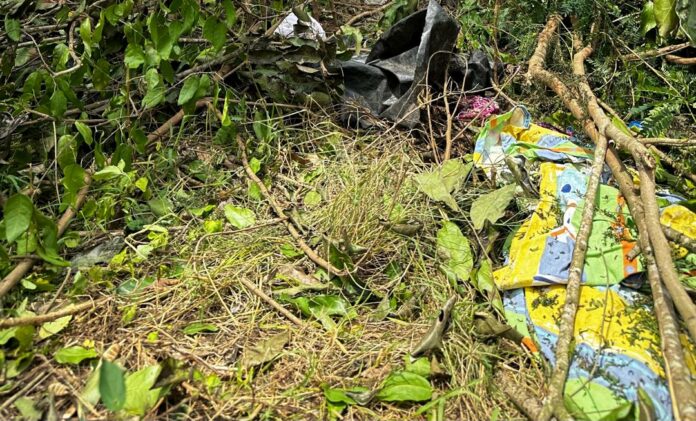I arrived in Gomoa-Ojobi, a village in Ghana’s Central Region, ten days after she died. The air was heavy with sadness, a heavy weight that seemed to hang over the community.
An unspeakable tragedy had occurred in this seemingly peaceful village, leaving a lasting impression on everyone who knew it.
The spot where an elderly woman, forsaken by those who should have cared for her still feels heavy as residents say. The memory of her suffering is telling, engraved deeply into the hearts of the villagers who pass by each day, unable to forget the haunting tragedy.

With both legs deteriorating, there was a powerful stench emanating from the body. After a hectic struggle throughout the day and night, for a week, she finally gave up her soul and died on June 10, 2024.
Remains of the woman like her cover cloth, a plastic rubber that served as a bed and other items of hers are still left there. Residents feel they could have done better before her demise even though they tried their best.

The grown leaves which served as a shade and abode for the woman after she was abandoned has all been cut down with an inscription pasted on the trunk of the trees there.

It all began with a tragic road crash in Gomoa Ojobi one afternoon. The old woman, suspected to be suffering from a mental illness, was among the victims. She was taken to the Winneba Trauma and Specialist Hospital, where she stayed for two months. But unlike the other victims, no family came to visit her, no one came to take her home.
The hospital staff did their best, but with little information to work with with, only that she was from Gomoa Ojobi—they struggled to find her family. And so, she remained alone, a nameless figure lost in the system.
When she was finally discharged, the hospital staff allegedly took her to the outskirts of Ojobi. Here, on a desolate bush road between the Gomoa Ojobi Presbyterian Church and the Perez Chapel in Ojobi, she was abandoned.

For a week, she lay there, ants crawling over her legs. According to eyewitnesses, her cries of pain were frequent day and night, a haunting signal of her immense suffering.

Eric Amoako Baffo, a resident deeply moved by the woman’s story, recounted what he witnessed:
“It was heartbreaking to see her lying there, helpless and in pain. We tried to help, but there was only so much we could do.”
Akos Opare, another resident who lives right opposite where the woman was abandoned, told me how an ambulance dumped the woman at the site, leaving her to struggle all by herself:
“I saw the ambulance leave her there. She was in so much pain, and there was nothing I could do to ease her suffering.”

Vida Anaman and Akos Opare still walk past the spot daily, haunted by the hope that they could have done more to save the woman’s life:
“Every day, I think about her and wonder if there was something more we could have done. Her cry is still stuck in my mind.”
No one came to her rescue. And here, she died, alone and in agony.
The Assemblyman for the area, Geoffrey Payin Inkum, expressed his concern over the incident: “We are deeply saddened by what happened. This should never have occurred, and we must ensure it never happens again.”
The outcry from the public was immediate and fierce. In response, the Ghana Health Service suspended the Medical Director of the Winneba Trauma and Specialist Hospital, Dr. George Prah, pending an investigation. A committee was set up to uncover the truth within 30 days.
This prompted me to visit the Winneba Trauma and Specialist Hospital, where it all began, to understand how such a tragedy could occur and to ensure that no one else suffers the same fate.
As the investigation proceeds, the community of Gomoa Ojobi remains united in their grief and determination to seek justice for the woman who was abandoned in her time of greatest need.
By Godwin Asediba












